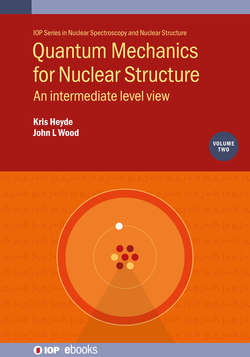Читать книгу Quantum Mechanics for Nuclear Structure, Volume 2 - Professor Kris Heyde - Страница 8
На сайте Литреса книга снята с продажи.
IOP Publishing Quantum Mechanics for Nuclear Structure, Volume 2 An intermediate level view Kris Heyde and John L Wood Chapter 1 Representation of rotations, angular momentum and spin
ОглавлениеThe various representations of rotations in physical space, (3,R) and Hilbert space (n,C) are developed in detail. This leads to an in-depth treatment of the representation of states of well-defined spin and angular momentum in quantum systems. The peculiarities of the physics of spin-12 systems (spinors) are outlined. The tensorial character of representations is implicit in the treatment. The Schwinger and Bargmann representations are introduced in some detail; and this leads to SU(2) coherent states (which are important for more advanced group representation theory).
Concepts: Euler angles; matrix representations; Pauli spin matrices; ket rotations; SU(2) and SO(3) tensor representations; Schwinger representation; spherical harmonics as Cartesian tensors; spin-12 neutron interferometry; Bargmann space; measure of a space; SU(2) coherent states; non-unitary representations.
Angular momentum and spin are dynamical variables that are fundamental to finite systems in quantum mechanics, i.e. for molecules, atoms, nuclei and hadrons. To fully handle the quantum mechanics of these systems, the mathematical representation of rotations is fundamental. Some elements of these issues in quantum mechanics are introduced in Volume 1. Namely, the concept of a group, the use of matrices, the distinction between rotations in physical space, (3, R), and Hilbert space is presented in chapter 10; and the basic quantization of spin and angular momentum, using algebraic methods, is presented in chapter 11. Further, the facility with which these methods reduce the solution of central force problems in quantum mechanics to simple algebraic problems in terms of a single (radial) degree of freedom is presented in chapter 12.
The mathematical representation of rotations is a rich paradigm for the whole of quantum mechanics. In this chapter, a wide range of mathematical tools is introduced. Matrix algebra and the algebra of polynomials in real and complex variables feature prominently. The peculiar physics of spin-12 particles and spinors is presented. But, the primary aim is to initiate a language that is suitable for the theoretical formulation of finite many-body quantum systems. Group theory and Lie algebras are implicit in the material presented in this chapter: the groups SO(2), SO(3) and SU(2) feature prominently in their behind-the-scene role. The road into many-body systems necessitates more complicated groups such as SU(3): some of the material in this chapter is intended to ‘pave’ this road.
